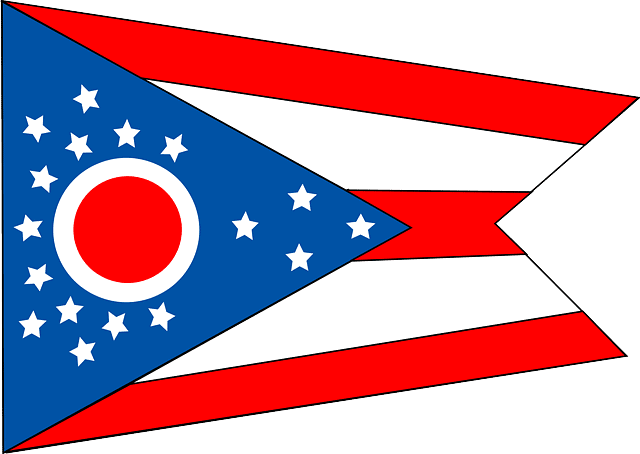
Table of Contents
Ohio is a constituent state of the U.S.A, located in the Midwest region of the country. It became the 17th state of the U.S. in 1803. Historically, Ohio was famously known as the ‘Buckeye State’ because of the abundance of buckeye trees growing across the region. Ohioans were referred to as the ‘Buckeyes’.
Ohio is a popular state for many reasons. It’s the home of several famous figures including John Legend, Drew Carey and Steve Harvey as well as many U.S. presidents. Ohio is also famous for being the birthplace of the Wright Brothers, which is why it’s often referred to as the ‘birthplace of aviation’.
Ohio is represented by several state symbols. Here are some of the most popular.
Flag of Ohio

The official flag of the state of Ohio was adopted by the legislature in 1902. The flag stands out from the others because of its unique burgee design (a swallow-tailed design), drawn by designer and architect John Eisenmann. It’s the only state flag which is different in shape.
The blue field on the flag represents the hills and valleys of the state and the 13 white stars surrounding the white circle are symbolic of the original 13 colonies. The other four stars increase the total number to 17 as Ohio was the 17th state to be admitted to the Union.
The white and red stripes represent the waterways and roads of Ohio whereas the circle with the red center forms the letter ‘O’ for Ohio. It also has a connection to the state nickname ‘The Buckeye State’, as it resembles an eye.
Seal of Ohio
The state of Ohio has had an official state seal for over 150 years during which time the government made several modifications to it, the final one done in 1996. The seal illustrates the diverse geography of the state and in its background is Mount Logan, located in Ross County. Mount Logan is separated from the rest of the seal by the Scioto River.
In the foreground stands a bushel of wheat as well as a freshly harvested field of wheat, representing the most important contributions of the state to agriculture. There are 17 arrows standing next to the wheat bushel, representing the state’s position in the union and the 13 rays of the sun represent the original 13 colonies.
Cardinal
The cardinal is a passerine bird native to North and South America. They’re seed-eating, robust birds with extremely strong bills. Their appearance varies in terms of color depending on the gender. When the Europeans first arrived in Ohio in the 1600s, the state was 95% forest and during this time, cardinals were rarely seen as they don’t tend to thrive in forests and prefer the edges and grassy landscapes. However, as the forests were gradually cleared, it became a more suitable habitat for the birds. By the end of the 1800s, cardinals were becoming accustomed to the modified forests of Ohio and they could be found all over the state. In 1933, the cardinal was adopted as the official bird of the state of Ohio.
Ohio Flint
Ohio Flint, a specialized type of microcrystalline quartz, is a durable and hard mineral. It was used by natives in the prehistoric and historic times to make weapons, ceremonial pieces and tools. Flint Ridge, in the Muskingum and Licking counties, was one of the main sources of flint for the Hopewell tribe living in Ohio. They traded flint with the other native people from across the United States and many artifacts made of flint from Flint Ridge have been discovered as far away as the Gulf of Mexico and the Rocky Mountains. Flint was also used in the past to make stone tools and to start fires.
Flint was adopted as the official gemstone of Ohio in 1965 by the General Assembly. Since it comes in a wide variety of color combinations such as pink, blue, green and red, it’s extensively used for making attractive pieces of jewelry and is highly prized by collectors.
The Ladybug
In 1975, the government of Ohio chose the ladybug as the official insect of the state. Today, there are hundreds of different species of ladybugs found in all corners of the state, existing in all 88 counties.
Although the ladybug may look small and pretty, it’s a ferocious predator that eats small pests like aphids, providing a great service to Ohio’s gardeners and farmers by minimizing the need for pesticides. What’s more, they don’t cause any damage to the crops.
The ladybug is also considered the bringer of gifts and good luck (especially when they land on someone) and some say that the number of spots on the ladybug’s back stands for the number of joyful months ahead.
Black Racer Snake
The black racer snake is a non-venomous reptile that’s actually extremely important to the farmers of Ohio because it kills various rodents that cause damage to crops. Eating almost any animal it can overpower, black racers are dangerous only when they’re handled, especially after being in captivity for months in which case they’ll flail wildly and defecate an incredibly foul-smelling musk. In 1995, the Ohio Legislature adopted the black racer as the official reptile because of its high prevalence in the state.
Blaine Hill Bridge
The Blaine Hill Bridge is the oldest sandstone bridge in Ohio, located over Wheeling Creek in Belmont County. It was built in 1826 as a part of the National Road project and is an impressive structure over 345 feet in length. It’s considered to be one of the most architecturally and historically significant structures in the state of Ohio.
In 1994, the bridge was closed to traffic and underwent reconstruction. It’s now a historical site and was adopted as the state bicentennial bridge in 2002, receiving the state symbol honor.
The Adena Pipe
The Adena Pipe is a 2000-year-old American Indian effigy pipe found near Chillicothe in Ross County, Ohio in 2013. According to the Historical Society of Ohio the pipe, made of Ohio pipestone, is unique since it’s a tubular artefact, formed in the shape of a person. What the pipe represents is still unknown, but archaeologists state that it could represent a mythological figure or an Adena man. In 2013, the pipe was named the official artefact of the state of Ohio by the state legislature.
The Ohio Buckeye
The buckeye tree, commonly known as American buckeye, Ohio buckeye or fetid buckeye, is native to the lower Great Plains and Midwestern regions of the U.S. Officially named the state tree of Ohio in 1953, the buckeye tree has red, yellow and yellowish-green flowers and its seeds which are inedible contain tannic acid which make them poisonous to both humans and cattle.
The Native Americans extracted the tannic acid in the buckeye nuts by blanching them and used them to make letter. They also dried the nuts and made necklaces out of them like those made from kukui nuts in Hawaii. The tree also provided the people of Ohio with their nickname: the Buckeyes.
White Trillium
The white trillium is a type of perennial flowering plant native to North America. It’s most commonly seen in rich, upland forests and is easily recognized by its beautiful white flowers, each with three petals. Also called the ‘wake robin’, the ‘snow trillium’ and the ‘great white trillum’, the flower is said to be the most popular American wildflower and was designated the official wildflower of Ohio in 1986. The reason it was chosen over all the other flowers in the state was because it exists in all 88 of Ohio’s counties.
‘Beautiful Ohio’
The song ‘Beautiful Ohio’ was written by Ballard MacDonald in 1918 and designated as the state song of Ohio in 1969. It was originally written as a love song until Wilbert McBride rewrote it with the permission of the Ohio Legislature. He altered the lyrics, giving a much more specific and accurate portrayal of the state by including things such as its factories and cities rather than two lovers.
The original version of ‘Beautiful Ohio’ is usually performed several times a day during the Ohio State Fair, by the All State Fair Band. It was performed by the Ohio State University Marching Band at the Inauguration of Presidents George Bush and Barrack Obama.
The Paragon Tomato
In the past, a majority of Americans considered tomatoes to be little fruits that had a bitter taste. However, this changed when the Paragon Tomato was developed by Alexander Livingston. Paragon tomatoes were larger and sweeter and led to Livingston developing over 30 other types of tomatoes. Thanks to Livingston’s work, the popularity of the tomato increased and it was used by American cooks, gardeners and diners. Today, the farmers of Ohio harvest over 6,000 acres of tomatoes, most of it in the north western region of the state. Ohio is now the third largest producer of tomatoes in the U.S. and in 2009, the tomato was named the official state fruit.
Check out our related articles on other popular state symbols:








